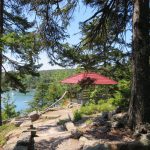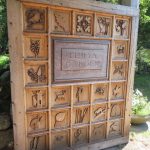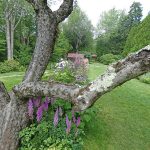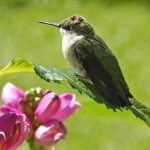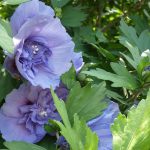
Maine Home Garden News — February 2022
In This Issue:
- Editors Note: Much Love for the Maine Home Garden Newsletter Team!
- February Is the Month to . . .
- A Review of The Green Gardeners Guide: Simple, Significant Actions to Protect & Preserve Our Planet by Joe Lampl
- The Adventures of Raising Seedlings “Off the Grid”!
- Great Horned Owls
- Updates to Maine’s Invasive Plant List
- Maine’s Public Gardens: Thuya Gardens
- Reader Exchange
- Maine Forest Service Launches Browntail Moth Awareness Month
Editor’s Note: Much Love for the Maine Home Garden Newsletter Team!

As I prepare the newsletter each month, I find myself forever grateful for the team that makes this publication possible. We clearly have an incredible group of contributors offering informative and entertaining content, but we also have deeply committed volunteers and staff working behind the scenes. The following folks take great care editing content, designing the web and email platforms, maintaining email lists, and getting hard copies mailed to those who don’t have access to the internet: Abby Zelz, Annika Schmidt, Barbara Harrity, Cindy Eves-Thomas, Mary Michaud, Michelle Snowden, Naomi Jacobs, Phoebe Call, and Wendy Roberston. This wouldn’t happen without them!
February Is the Month to . . .
By Kate Garland, Horticulture Professional, UMaine Extension Penobscot County
- Take care of yourself now so you can take care of your garden this spring. It’s important to prepare your body for the hard physical work of growing food, flowers, and stunning landscapes. Regular stretching and some aerobic exercises can make a big difference in how you feel when the season kicks off.
- Get a jump start on spring by forcing branches indoors. Forsythia and crabapple are common favorites for this spring tradition, but you can savor glimpses of warmer days ahead by placing any fresh woody branch cuttings in water indoors. Not all branches will produce flowers, but they should all eventually leaf out. Other woody plants to consider include tamarack, apple, quince, pussy willow, cherries, alder, and birch. Try a few different options; you might be surprised by what you see!
- Make cut flowers last longer. While the cut end of flowers are submerged in water, give them an extra trim before putting them in a vase. Trimming ends underwater, adding flower preservatives, and keeping arrangements in a cooler location in the house can significantly extend the longevity of any arrangement.
- Order seeds and gather your seed starting supplies. If you haven’t already ordered, don’t delay! Many items are already back-ordered or fully sold out for the season. Replacing aging fluorescent bulbs in your grow light fixtures, even if they haven’t fully gone dark, can greatly enhance the quantity of light and lead to more robust seedlings.
- Order bare-root trees and shrubs. According to “What’s to Love About Bare Root Plants?” “A bare root plant is grown in the field until it is the right size to be sold (usually still relatively young) and dug up when dormant. After the soil is washed from the roots, the plant is kept in cold storage, and delivered to you before its buds break.” They’re resilient, more affordable than container plants of comparable size, and typically have a better long-term establishment. However, they’re only available to order in the winter and spring months.
- Start select types of seeds indoors such as geranium, snapdragon, onions, shallots, leeks, and petunia. Be sure to hold off on sowing other types until the time is right. See our bulletin #2751, Starting Seeds at Home for a helpful chart, and watch for reminders on when to start other seeds in future issues of the Maine Home Garden News. Sowing too early wastes energy and often leads to crowding, disease, insect pressure, and lanky plants.
- Give your houseplants a spin and a little dusting. Our bulletin #2611, Tips for Growing Houseplants in Maine: Caring for Houseplants in Maine, suggests that we “turn them occasionally to expose all sides to the light source. Also, wash the leaves regularly to remove dust accumulation, but do not use any oily substance on the leaves to keep them shiny—it attracts dust.”
A Review of The Green Gardener’s Guide: Simple, Significant Actions to Protect & Preserve Our Planet by Joe Lampl
(Cool Springs Press, 2008)
Reviewer: Clara Ross, Penobscot County Master Gardener Volunteer
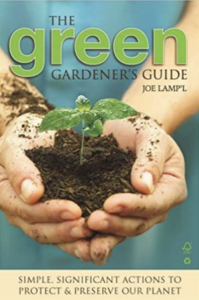
Some of you may already be familiar with the cheerful demeanor and excellent teaching methods of Joe Lampl, as demonstrated on his PBS series “Growing a Greener World,” blogs, and podcasts. Joe is considered a leader in the sustainability movement. Back in 2008, Joe published this guidebook, which I consider to still be a comprehensive resource for green gardening.
This is a go-to handbook if you are looking for ways to capture, conserve, or redirect water on your property. Other topics include the negative impact of lawns on the environment, an extensive section on reusing/recycling your household and garden waste, and so much more, including ways to be proactive in helping your community integrate green gardening principles.
Facts I learned (true confessions, so please don’t laugh!):
- 97% of insects are beneficial or harmless, so leave them be.
- Tilling reduces the earthworm population by as much as 90% (I just thought this was interesting; I haven’t tilled for 35 years)
- Using clear thin (2 mil or less) plastic sheeting to sterilize weed seeds or kill weeds is faster and more effective than heavy (4-6 mil) black poly sheeting. I sure wish I’d known that fact this past summer before investing $$$ in 6 mil black poly to kill weeds in a large area at my new house!
Though more recent publications on sustainable gardening are available, this 2008 guide still provides an excellent basis for supporting gardeners to help our planet to heal. The book is out of print, but used copies can be found online for as little as $1 + shipping.
The Adventures of Raising Seedlings “Off the Grid”!
By Sandra Mitchell, Penobscot County Master Gardener Volunteer
The main article was originally written in April 2021 and is followed by a season recap.
I have always raised seedlings, whole generations of gardens started in the house with the dreams of summer begun in the deep of winter. It was a rite of passage, with thoughts of longer days to come.
Then I moved to my dream house, off the grid with only a single solar panel, no running water, and wood for heat. A nature person’s delight, right? Until I tried to start seeds.
I discovered all of the nuances of starting seeds — the house was dry and the babies needed more water than I was used to. Easily accomplished with some plastic and a spray bottle. Check. The temperature fluctuated a LOT from very hot to quite cold if I was gone for more than 5 hours, let alone overnight. It seems seedlings don’t like this! As a backup plan for emergencies (like being out of commission with CoViD!), I had a very small propane heat device installed upstairs where I spend my time. This allowed me to take the seedlings away from the wood stove in the basement and place them near this (turned off) heater. As it turned out, even though the upstairs often runs a cool 60 degrees, the steady heat from the pilot seems to keep the seeds happy even though the heater is not on! Problem 2 solved. Check! And then there is the problem of lighting. I don’t have enough solar power to run grow lights on cloudy days, and even on sunny days, I can only run 1 LED strip at a time. This was a harder nut to crack.
As it turned out, the solution was in an unexpected place. I changed from using the traditional seedling trays to blocks. This was a HUGE advantage. Usually, I wind up with a large number of flats (last year I think I hit 18?) that weren’t totally full, or lumped together plants that didn’t want the same conditions (like bell peppers next to brussels sprouts…operator error!). With the blocks, I could start tomatoes and cabbage side by side, and once they sprouted, separate them out. This let me put the cold-loving plants on a sunroom porch all day, even in quite chilly weather, to get sun and get hardened off early on. And I could light only the plants that really NEEDED to stay warm and bright. By wrapping the trays completely in reflective material, I could use fewer lights than normal. I still had to rotate seedlings between the lights and the south-facing window sills, but that was far better than trying to get light to a zillion flats. And, if a seedling didn’t “take,” it was easy to simply pull that block out and make room for the next one coming out of the germination tray. I’d still like better lighting but, for now, another problem solved. CHECK!
Off-the-grid life certainly comes with its challenges. And I’m sure that next year’s crop of seedlings will throw me more curveballs. But this is my 4th year of raising seedlings under the new conditions, and I’d say these are the healthiest kids I’ve had in April so far. Let’s hope the results are being canned in August!
2021 Garden in Review
So here I sit surrounded by catalogs, placing my 2022 seed orders. It would probably be wise to review what worked and what didn’t, learn from those mistakes, and then order/seed accordingly. But no, I make the same mistakes every year — after all, who doesn’t need 8,000 tomato seedlings? Looking back at the seeds started last year, though, teaches some memorable lessons.
First, no one, and I mean no one, needs to plant as many squash as I managed to plant. The plan was to have enough to can and dry, plenty for winter storage, and some to give away. I am now on a first-name basis with every food bank within 30 miles and delivered squash to every neighbor living within a mile of me. I was to the point at the end of the season of dropping off the squash in the middle of the night and running before people could return them to me. There WILL be fewer squashes in my future.
I also learned that I need to improve my identification techniques. Some plants labeled celeriac produced lovely fennel bulbs and at some point, I managed to mix up and swap around my entire herb seedling patch. Fortunately, they all seemed to enjoy where I planted them.
Some things are better started as roots or sets. I started a zillion asparagus seeds, and the seedlings looked super going out in the garden. However, they grew slowly and soon could not outcompete the weeds. Results were similar with my onion seeds. I need to either improve my weeding techniques (okay, yes, I do) or figure out a better way to give these kids the support they need when they go out. The simplest solution would be to purchase sets, but I’m too stubborn to do that.
And perhaps the best lesson of all. Where your garden fails, someone else thrives. In exchange for my bounty of squashes, I received early season cucumbers from neighbors (mine were quite late this year), carrot tops for my chickens (my carrots also succumbed, largely to my poor weeding habits, something I’ve vowed to improve this year), and a HUGE bounty of heirloom tomatoes late in the year, after mine had frosted. On one of my last “hit and run” donations of squash to a food bank, one of the workers ran out with a flat of grapes and a large apple pie. Little did I know that within days I would be infected with CoViD and unable to leave the house and boy did that food come in handy!
So as I sit here planning my 2022 garden, I am sure there will be too many tomatoes, more unlabelled mystery plants, and gaps that my generous neighbors will help fill in. However, I vow to plant fewer squash. In fact, I’m only ordering 4 varieties!

Great Horned Owls
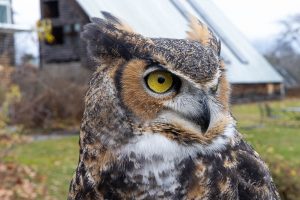
By Doug Hitchcox, Maine Audubon Staff Naturalist
Even in the thick of winter, you might hear Great Horned Owls hooting back and forth to each other through the cold nights. Pairs often call together; the larger, deeper voice is the males. Along with the Barred Owl, it’s the most widely distributed owl in Maine. A four-foot wingspan makes it an impressive sight in flight. Great Horned Owls tend to nest unusually early for birds in the north and are thought to be Maine’s earliest nesting bird, possibly to give the young more time to learn hunting skills, or possibly for this nocturnal bird to take advantage of the long winter nights. Great Horned Owls are not fussy nesters; they’ve been known to make their nests in other birds’ abandoned nests, cavities in both dead and live trees, and even deserted buildings.
For more on the importance of Maine native plants to support birds and other wildlife, visit Maine Audubon’s “Bringing Nature Home” webpage.
Updates to Maine’s Invasive Plant List
Most home gardeners have had to do battle with plants that refuse to stay within bounds, whether rhizomatic spreaders like bishop’s weed, creeping bellflower, and Japanese knotweed, or rampant self-seeders like barberry, buckthorn, and Norway maple. Invasive plants are not native members of Maine ecosystems. They have the potential to invade natural habitats and overwhelm valuable native species, causing economic as well as ecological damage.
In 2016 the state began to regulate the sale of such problem plants by establishing Chapter 273 of the Maine Administrative Code, Criteria for Listing Invasive Terrestrial Plants. The rule made it illegal to “import, export, buy, sell or propagate for sale or distribution” 33 species designated as “Invasive,” “Likely Invasive,” and “Potentially Invasive.” A one-year transition period was allowed for listed plants already being sold in Maine. When that period ended on December 31, 2017, the restrictions went into full effect. The rule also required the species list to be reviewed and amended on a five-year basis.
The first five-year review began in early 2021, when the Department of Agriculture, Conservation and Forestry (DACF) Horticulture Program assembled a stakeholder committee to review the rule and help identify proposed species to add to or remove from the list.
The committee was comprised of individuals from industry, government, non-profit, and educational institutions. They represent organizations affected by the development, implementation, and enforcement of the prohibited plant list.
As Chapter 273 restricts only the sale of invasive plants, the committee considered only plants known to be sold in or imported into Maine.
The committee has met five times since March of 2021. In April, 173 candidate species were narrowed to 81 priority plants and another 31 of possible concern. During the spring and summer, the Maine Natural Areas Program staff and the DACF Plant Health staff conducted detailed evaluations of these 112 species. In November the committee reviewed these evaluations and decided to eliminate 49 plants in the “hitchhiker” category. Hitchhiker plants are not sold directly but can infiltrate plant pots or tree and shrub root balls. Many hitchhiker plants are grasses that are extremely difficult to identify in their immature stages, making them almost impossible to regulate. These potential invasives will be addressed through increased outreach to nurseries regarding best management practices for weeds in nursery stock.

At their January 2022 meeting, after a deep dive into the evaluations, the committee further narrowed the list and recommended 30 species for addition to Chapter 273. The committee also recommended adding a new “Watch List” of 29 plants that have shown invasive potential in other areas of the northeast but do not appear to be a threat in Maine currently. Though not listed for regulation at this time, they will be reconsidered in the next 5-year evaluation to see if climate change has increased the threat they pose. Four other plants of concern were removed from consideration for various reasons: creeping jenny, European blackberry, sheep sorrel, and common periwinkle, aka Vinca minor.
The committee will meet one more time in February to discuss revisions to Chapter 273, such as adding the watch list; better defining some terms such as biological potential, minimally managed habitats, and spatial gaps; and improving the variance section. The group would like to establish specific thresholds for exempting species, hybrids, or cultivars that are shown to be sterile or no longer invasive.
The Plant Health Program hopes to publish a proposed rule for comment, by the middle of March. A public hearing will be followed by a 10-to 30 day period for written comments. Comments are welcome at any time, but most important during the official rulemaking comment period.
Plants to include in the proposed rule:
| Scientific name | Common name |
|---|---|
| Alnus glutinosa | European alder |
| Angelica sylvestris | Woodland angelica |
| Anthriscus sylvestris | Wild chervil, Raven’s wing |
| Aralia elata | Japanese angelica tree |
| Butomus umbellatus | Flowering rush |
| Elaeagnus angustifolia | Russian olive |
| Euonymus fortunei | Wintercreeper |
| Festuca filiformis | Fine-leaved sheep fescue |
| Ficaria verna | Lesser celandine |
| Glaucium flavum | Yellow hornpoppy |
| Glechoma hederacea | Ground ivy, Creeping Charlie |
| Glyceria maxima | Great mannagrass, Reed mannagrass |
| Hippophae rhamnoides | Sea buckthorn |
| Ligustrum obtusifolium | Border privet |
| Lonicera xylosteum | Dwarf honeysuckle |
| Lythrum virgatum | European wand loosestrife |
| Miscanthus sacchariflorus | Amur silvergrass |
| Petasites japonicus | Japanese fuki, butterbur, giant butterbur |
| Phalaris arundinacea | Reed canary grass, Variegated ribbon grass |
| Photinia villosa | Oriental photinia, Christmas berry |
| Phragmites australis | Common reed |
| Phyllostachys aurea | Golden bamboo |
| Phyllostachys aureosulcata | Yellow groove bamboo |
| Pyrus calleryana | Callery (“Bradford”) pear |
| Ranunculus repens | Creeping buttercup |
| Rubus phoenicolasius | Wineberry |
| Silphium perfoliatum | Cup plant |
| Sorbus aucuparia | European mountain-ash |
| Tussilago farfara | Coltsfoot |
| Valeriana officinalis | Common valerian |
Maine’s Public Gardens: Thuya Gardens
By Kate Garland, Horticulture Professional, UMaine Extension Penobscot County
Maine is adorned with countless public gardens in nearly every corner of the state. They’re a source not only of beauty, but of inspiration and peace. Keep an eye out for tributes to these botanical treasures in future issues of the Maine Home Garden News, and reach out to us to nominate your own favorite public garden. Here’s one to kick us off!
I enjoyed visiting Thuya Gardens in Northeast Harbor many times throughout my childhood with my grandparents and extended family. My preferred approach is the switchback Asticou Terraces path* that climbs a wooded hillside overlooking the harbor. It’s just one of many unique features that make this one of my favorite Maine gardens. The rustic 1916 lodge that greets you at the top of the path takes you back in time to a summer home turned museum and reading library. Volumes of horticultural, natural history, and local history books line the walls along with botanical artwork and historical artifacts. Outside, giant wooden doors carved with birds, plants, and wildlife create a grand entrance to the garden.
Photos by Lorraine Evans
The “bones” of the garden — large trees, rocky slopes, and granite outcroppings — are softened by a colorful mix of annuals and perennials, linked by enticing groomed paths. Visitors will find several quiet places to sit and reflect on the cultivated gardens and equally stunning natural backdrop. If you’re in the mood for hiking, the 1.3 mile Eliot Mountain Trail can be entered directly from the garden.
Photos by C. Eves-Thomas
I hope you take the time to see it for yourself. Visitors not inclined to climb the terrace path can reach the garden by car via the one-lane Thuya Drive. Oh, and if the gardens aren’t enticing enough, I also have fond memories of pairing a visit with a stop for popovers and tea at the nearby Asticou Inn, where my dad worked as a concierge for a few summers. The Asticou Azalea Gardens across from the Inn deserve their own special tribute in a future issue.
Thuya Garden
*See #2 Asticou Terraces and Path on this map (PDF).

Reader Exchange
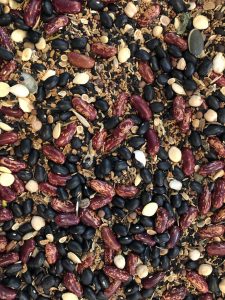 Many seed packets offer way more seeds than I would need in a single season. While most types can stay viable for 3-5 years, I found myself with several packets over 5 years old. Instead of dumping my ancient stockpile into the compost, my 4-year-old and I had a great time emptying each packet into a bin. She marveled at the “beautiful mess” and we noted differences and similarities between each type. Afterward, she spent a solid half-hour spooning the seeds into envelopes and old spice jars. We eventually added them to a sensory bin we already created using popcorn, rice, and oat seeds.
Many seed packets offer way more seeds than I would need in a single season. While most types can stay viable for 3-5 years, I found myself with several packets over 5 years old. Instead of dumping my ancient stockpile into the compost, my 4-year-old and I had a great time emptying each packet into a bin. She marveled at the “beautiful mess” and we noted differences and similarities between each type. Afterward, she spent a solid half-hour spooning the seeds into envelopes and old spice jars. We eventually added them to a sensory bin we already created using popcorn, rice, and oat seeds.
Our readers have a lot of experience and great ideas. Therefore, we decided it’s high time you chimed in with some of your favorite gardening tips and tricks. Each month, we’re challenging you to send us gardening “hacks” that make your horticultural life more fun and productive. If your submission is selected, we’ll provide you with a free soil test with the Maine Soil Testing Service. Submit your ideas to katherine.garland@maine.edu with the email subject “Reader Exchange”.
Maine Forest Service Launches Browntail Moth Awareness Month
AUGUSTA — February 2022 has been recognized as Browntail Moth Awareness Month in Maine to encourage people to take advantage of the dormant season of the insect and join together to reduce impacts from browntail moth (BTM).
BTM populations in Maine have been in an outbreak phase since 2015 and the pest cannot be eradicated. Most areas of Maine, especially settled areas with significant host tree populations such as oak, apple, crabapple, pear, birch, cherry, or other hardwoods, are at risk of infestation by the caterpillars. While long-lasting tree defoliation and branch dieback are major concerns, BTM’s microscopic, toxic hairs can cause trouble breathing and skin irritation similar to poison ivy from a few hours up to several weeks.
The Maine Forest Service (MFS) Forest Health and Monitoring Division coordinates within state government, local communities, and directly with citizens to respond to this issue. Winter is the best time to clip and destroy BTM winter webs within reach or hire licensed arborists or pesticide applicators to reduce out-of-reach populations. Comprehensive BTM information and tools compiled by MFS, Board of Pesticides Control, Maine Center for Disease Control, the University of Maine, and other partners including research, infestation tracking, FAQs, and educational resources for communities, municipalities, businesses, and healthcare providers, are available on maine.gov/dacf/knockoutbtm.
Follow the Four Rs to “Knock Out BTM” In our communities and reduce the itch!
Do you appreciate the work we are doing?
Consider making a contribution to the Maine Master Gardener Development Fund. Your dollars will support and expand Master Gardener Volunteer community outreach across Maine.
Your feedback is important to us!
We appreciate your feedback and ideas for future Maine Home Garden News topics. We look forward to sharing new information and inspiration in future issues.
Subscribe to Maine Home Garden News
Let us know if you would like to be notified when new issues are posted. To receive e-mail notifications, click on the Subscribe button below.
University of Maine Cooperative Extension’s Maine Home Garden News is designed to equip home gardeners with practical, timely information.
For more information or questions, contact Kate Garland at katherine.garland@maine.edu or 1.800.287.1485 (in Maine).
Visit our Archives to see past issues.
Maine Home Garden News was created in response to a continued increase in requests for information on gardening and includes timely and seasonal tips, as well as research-based articles on all aspects of gardening. Articles are written by UMaine Extension specialists, educators, and horticulture professionals, as well as Master Gardener Volunteers from around Maine, with Katherine Garland, UMaine Extension Horticulturalist in Penobscot County, serving as editor. Special thanks to our Master Gardener Volunteer co-editors Naomi Jacobs and Abby Zelz.
Information in this publication is provided purely for educational purposes. No responsibility is assumed for any problems associated with the use of products or services mentioned. No endorsement of products or companies is intended, nor is criticism of unnamed products or companies implied.
© 2022
Call 800.287.0274 (in Maine), or 207.581.3188, for information on publications and program offerings from University of Maine Cooperative Extension, or visit extension.umaine.edu.
The University of Maine is an EEO/AA employer, and does not discriminate on the grounds of race, color, religion, sex, sexual orientation, transgender status, gender expression, national origin, citizenship status, age, disability, genetic information or veteran’s status in employment, education, and all other programs and activities. The following person has been designated to handle inquiries regarding non-discrimination policies: Director of Equal Opportunity, 101 North Stevens Hall, University of Maine, Orono, ME 04469-5754, 207.581.1226, TTY 711 (Maine Relay System).


